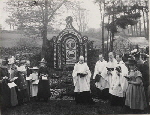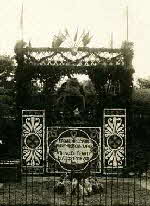|
 The true origins of Well Dressing are lost in the mists of time. According to many sources, it developed from a pagan custom of making sacrifice to the gods of wells and springs to ensure a continued supply of fresh water. Like many folk traditions, it was later adopted by the Christian Church as a way of giving thanks to God for His gift to us of water. Tradition has it that it took on a special significance in 17th century Derbyshire as various villages, notably Tissington, gave thanks for their deliverance from the Plague which had decimated nearby Eyam. In truth they had been spared by the altruism of the inhabitants of Eyam, who quarantined themselves while the disease, accidentally introduced in a package of clothing from London, ran its deadly course. Of course, this does not mean that the other villages has any less cause to express their grateful thanks. The true origins of Well Dressing are lost in the mists of time. According to many sources, it developed from a pagan custom of making sacrifice to the gods of wells and springs to ensure a continued supply of fresh water. Like many folk traditions, it was later adopted by the Christian Church as a way of giving thanks to God for His gift to us of water. Tradition has it that it took on a special significance in 17th century Derbyshire as various villages, notably Tissington, gave thanks for their deliverance from the Plague which had decimated nearby Eyam. In truth they had been spared by the altruism of the inhabitants of Eyam, who quarantined themselves while the disease, accidentally introduced in a package of clothing from London, ran its deadly course. Of course, this does not mean that the other villages has any less cause to express their grateful thanks.
 In the early days, the dressing of wells would have taken the form of simple arrangements of flowers and other natural materials. In this form it takes place today in many parts of the world. The unique Derbyshire tradition of elaborate pictures made for the most part of individual flower petals pressed onto clay covered boards seems to date from Victorian times, when there were many movements afoot to revive and enhance old folk traditions. The earliest recorded examples are in Tissington, but the tradition quickly spread to other villages. Sometimes, as in Youlgrave, the Dressings appeared at the village taps (pumps or fountains) to celebrate the arrival of piped water; hence the reason why they are sometimes known as Tap Dressings. In the early days, the dressing of wells would have taken the form of simple arrangements of flowers and other natural materials. In this form it takes place today in many parts of the world. The unique Derbyshire tradition of elaborate pictures made for the most part of individual flower petals pressed onto clay covered boards seems to date from Victorian times, when there were many movements afoot to revive and enhance old folk traditions. The earliest recorded examples are in Tissington, but the tradition quickly spread to other villages. Sometimes, as in Youlgrave, the Dressings appeared at the village taps (pumps or fountains) to celebrate the arrival of piped water; hence the reason why they are sometimes known as Tap Dressings.
Quite a number of town and villages have a long standing tradition of Well Dressing going back to the late 19th or early 20th centuries. Others have come and gone over the years, but the last few decades of the 20th century saw a great revival of the craft, with many villages in Derbyshire taking up the tradition. Villages in other counties did so too, often as a result of a former Derbyshire resident moving there. A kind of peak was reached with the Millennium Year when everyone seemed to pull out all the stops to make a great celebration. After that a slight malaise seemed to set in and a number of established venues disappeared from the calendar.
|